The Creators Project gets exclusive behind-the-scenes access to the cross-country U.S. tour of renowned South African artist Esther Mahlangu. As she travels through New York, Los Angeles, Chicago, D.C. and Atlanta, we get insight into the craft, skill, matrilineal tradition, innovation, and inspiration behind her larger body of work, as well as the original pieces she created for this (Belvedere)RED campaign, raising money for the Global Fund to fight and eliminate the transmission of HIV/AIDS.
In the 18th century the Ndzundza Ndebele people of South Africa created their own tradition and style of house painting. Until the late 1900s, the Ndebele people were very fierce warriors and large landowners. In the autumn of 1883, they went to war with the neighboring Boer workers. The loss of the war brought on a harsh life and horrible punishments for the Ndebele. Through those hard times expressive symbols were generated by the suffering people expressing their grief. These symbols were the beginning of the African art known as Ndebele house paintings.
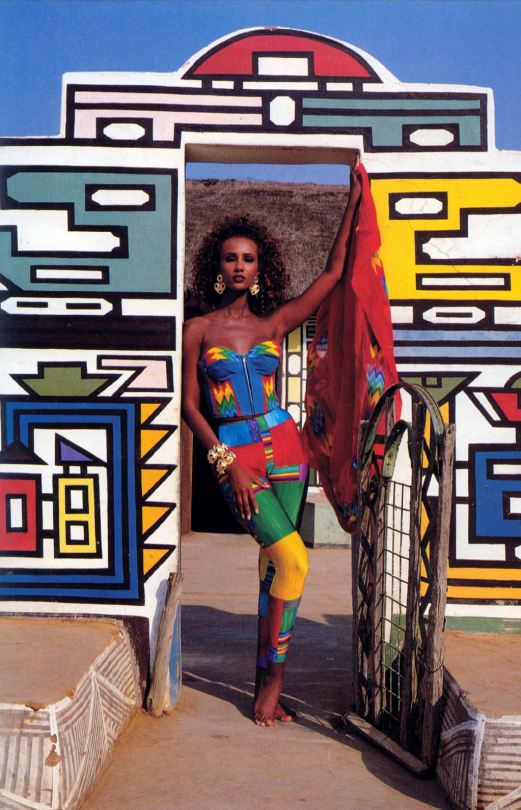
The Ndebele tribe originally in the early 18th century lived in grass huts. They began using mud-walled houses in the mid-18th century when these symbols begin to be created on their houses and walls. These expressive symbols were used for communication between sub-groups of the Ndebele people.
They stood for their continuity and cultural resistance to their circumstances. The Boer farmers did not understand the meaning and viewed it as cultural art that was not harmful, so it was allowed to continue. These wall paintings done by the women was their secret code to their people, disguised to anyone but the Ndebele.
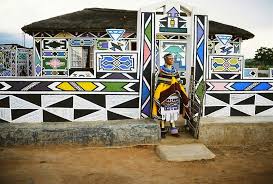
The vibrant symbols and expressions portray communications of personal prayers, self-identification, values, emotions, and marriage. Sometimes the male initiation, known as the wela, was a reason for repainting, but the ritual was not expressed. One quality of life that has never been expressed or directed through their walls is sacred expression. The rituals and religions have never been a part of the Ndebele’s house paintings.
The women of the Ndebele are often the tradition carriers and the main developer of the wall art of their home. The tradition and style of house painting is passed down in the families from generation to generation by the mothers.

A well-painted home shows the female of the household is a good wife and mother. She is responsible for the painting of the outside gates, front walls, side walls, and usually the interior of her home. One thing that has changed since the beginning of the house painting and the present-day wall art is their styles.
In the beginning of house painting their symbols and patterns were often based from Ndebele’s beadwork. The patterns were tonal and painted with the women’s fingers. The original paint on the house was a limestone whitewash. The colors added to make the paintings were mostly natural pigments consisting of browns, blacks, and ochers. Most of the patterns were of a V shape and a very simple triangle on a large shape of color. The patterns, earth tones, directions, and sizes were more important than the present-day vivid and bright colours.
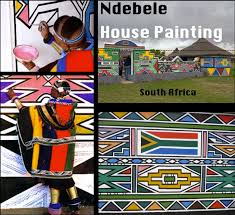
Colours
Over time, the colours and shape became a key aspect in the overall design. In the late 1968s, the new style was evident. What was once a finger-painted creation was now created using bundled twigs with feathers as brushes. The walls are still originally whitewashed, but the outlines and colours have significantly changed. The patterns and symbols can be seen today with a rich black outline and a vivid colour inside. There are five main colours represented: red and dark red, yellow to gold, a sky blue, green, and sometimes pink.
The colours give an intensified symbolic meaning to the Ndebele. They can mean status or power of the home’s owners, offer prayer, announce a marriage in the home, or can represent a current protest. The paintings express an abstract meaning with no real reference to any specific characteristic of their homes. This is the most direct way to show their individual expression to the people outside their far distinct family, showing of the talent and the taste of the mother. The colour white is always used as the background because it makes the bright patterns stand out more.
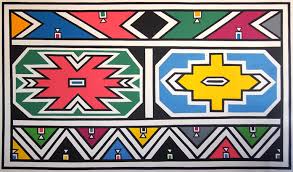
Patterns
The patterns are one of the most important aspects in their communication through painting. They are usually repeated throughout their design with only a very slight variation and different colour choice. The geometric patterns and shape are first drawn with the black outline and later filled in with colour. The patterns are grouped together throughout the walls in terms of their basic design structure. Creating the right tools to allow accuracy and freedom becomes a difficult task. The tools can’t restrict the painter from creating her art. They have to have tools for the large geometric shapes of flat colour and small brushes for the very small areas, outlines, and sacks. The advancement of tools has allowed faster and more complex designs throughout the Ndebele’s homes.
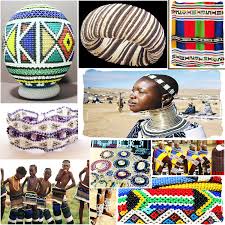
These very simple-looking painted houses are really a complex system of tradition and creation. This painted tradition is still alive. As every generation passes it down little changes begin to exist. This is their way of communication and expression through their home. The women work long and hard to finish these walls
and are noticed by the outside community because of their talent and expression.

Τον 18ο αιώνα, οι άνθρωποι της Ndzundza Ndebele της Νότιας Αφρικής δημιούργησαν τη δική τους παράδοση και στυλ ζωγραφικής σπιτιών. Μέχρι τα τέλη της δεκαετίας του 1900, οι άνθρωποι της Ndebele ήταν πολύ σκληροί πολεμιστές και μεγάλοι γαιοκτήμονες. Το φθινόπωρο του 1883, πήγαν στον πόλεμο με τους γειτονικούς εργάτες Boer. Η απώλεια του πολέμου έφερε μια σκληρή ζωή και φρικτές τιμωρίες για το Ndebele. Μέσα από αυτές τις δύσκολες στιγμές δημιουργήθηκαν εκφραστικά σύμβολα από τους ανθρώπους που υπέφεραν εκφράζοντας τη θλίψη τους. Αυτά τα σύμβολα ήταν η αρχή της αφρικανικής τέχνης γνωστής ως Ndebele house paintings.

Η φυλή Ndebele αρχικά στις αρχές του 18ου αιώνα έζησε σε καλύβες χόρτου. Άρχισαν να χρησιμοποιούν σπίτια με λάσπη στα μέσα του 18ου αιώνα, όταν αρχίζουν να δημιουργούνται αυτά τα σύμβολα στα σπίτια και στους τοίχους τους. Αυτά τα εκφραστικά σύμβολα χρησιμοποιήθηκαν για την επικοινωνία μεταξύ υποομάδων του λαού Ndebele. Αντάλλαξαν τη συνέχιση και την πολιτιστική τους αντίσταση στις περιστάσεις τους.
Οι αγρότες του Boer δεν κατάλαβαν το νόημα και το θεωρούσαν καλλιτεχνική τέχνη που δεν ήταν επιβλαβής, έτσι επέτρεψε να συνεχιστεί. Αυτές οι τοιχογραφίες που γίνονταν από τις γυναίκες ήταν ο μυστικός τους κώδικας στον λαό τους.
Τα ζωντανά σύμβολα και εκφράσεις απεικονίζουν τις επικοινωνίες των προσωπικών προσευχών, της αυτοδιάθεσης, των αξιών, των συναισθημάτων και του γάμου. Μερικές φορές η αρσενική μύηση, γνωστή ως βέλα, ήταν ένας λόγος για βάψιμο, αλλά το τελετουργικό δεν εκφράστηκε. Μια ποιότητα ζωής που δεν έχει ποτέ εκφραστεί ή κατευθυνθεί από τα τείχη τους είναι ιερή έκφραση. Οι τελετουργίες και οι θρησκείες δεν υπήρξαν ποτέ μέρος των ζωγραφικών έργων του Ndebele.
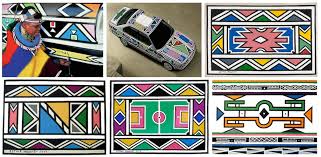
Οι γυναίκες της Ndebele είναι συχνά οι φορείς της παράδοσης και ο κύριος κατασκευαστής της τέχνης τοίχων του σπιτιού τους. Η παράδοση και το ύφος της ζωγραφικής κατοικιών μεταφέρονται στις οικογένειες από γενιά σε γενιά από τις μητέρες. Ένα καλά ζωγραφισμένο σπίτι δείχνει ότι η γυναίκα του νοικοκυριού είναι καλή γυναίκα και μητέρα. Είναι υπεύθυνη για τη ζωγραφική των μπροστινών τοίχων, των πλευρικών τοίχων και συνήθως στο εσωτερικό του σπιτιού της. Ένα πράγμα που έχει αλλάξει από την αρχή της ζωγραφικής του σπιτιού και της σημερινής τέχνης τοίχων είναι το στυλ τους.
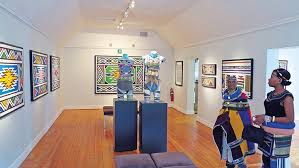
Τα μοτίβα ήταν μελωδικά και ζωγραφισμένα με τα δάχτυλα των γυναικών. Το αρχικό χρώμα στο σπίτι ήταν ασβέστης. Τα χρώματα που προστέθηκαν για να κάνουν τα έργα ζωγραφικής ήταν κυρίως φυσικές χρωστικές που αποτελούνται από καφέ, μαύρο και ώχρες. Τα περισσότερα σχέδια είχαν σχήμα V και ένα πολύ απλό τρίγωνο σε μεγάλο σχήμα χρώματος. Τα σχέδια, οι γήινες αποχρώσεις, οι κατευθύνσεις και τα μεγέθη ήταν πιο σημαντικά από τα σημερινά ζωντανά και φωτεινά χρώματα.


I can always rely on you to find me something amazing, Efi 🙂 🙂 Have a wonderful weekend!
LikeLiked by 1 person
Awww thank you so much!! The truth is that i feel the same for your posts!! The only difference is …. that you are visiting all these beauties in real….
Have a nice weekend …. mine is starting from today with Tom lol!!!! Kisses!!!
LikeLike
Kisses for Tom, too 😍🍨🍰💕xx
LikeLiked by 1 person
wonderful, that is good propaganda of the South African artworks
LikeLiked by 1 person
I love that woman and the art of all the people of the village!! Have a nice day Tony!!!
LikeLiked by 1 person
Thanks. Nice day to you too
LikeLiked by 1 person
One must be an artist to create such works. Beautiful and original.
greetings
LikeLiked by 1 person
this was informative – and our local museum in Richmond, Virginia (VMFA) has two huge pieces that Esther was commissioned to make – it is right at the entrance to the old african amercian art – very cools et up.
🙂
enjoyed this post
LikeLiked by 1 person
Good morning Yvette from Athens!!
Thank you for this information!! Have a nice Sunday!
https://www.vmfa.museum/explore/tours/vmfa-highlights/
LikeLiked by 1 person
🙂
LikeLiked by 1 person
PS – do you have any posts about el greco and his view of toledo?
__
I did not see a “search” option on your blog
LikeLiked by 1 person
I have not a post about him but i hope this link help you!
https://www.khanacademy.org/humanities/renaissance-reformation/renaissance-in-spain/a/el-greco-view-of-toledo
LikeLiked by 1 person
Thanks a lot
LikeLiked by 1 person
Good morning have a nice week!!!
LikeLiked by 1 person
😊
LikeLiked by 1 person
You also efe
LikeLiked by 1 person
Very striking.Great to learn about these vividly patterned wallart.🙏
LikeLiked by 1 person
Thanks for stopping by, much appreciated!!!
LikeLike